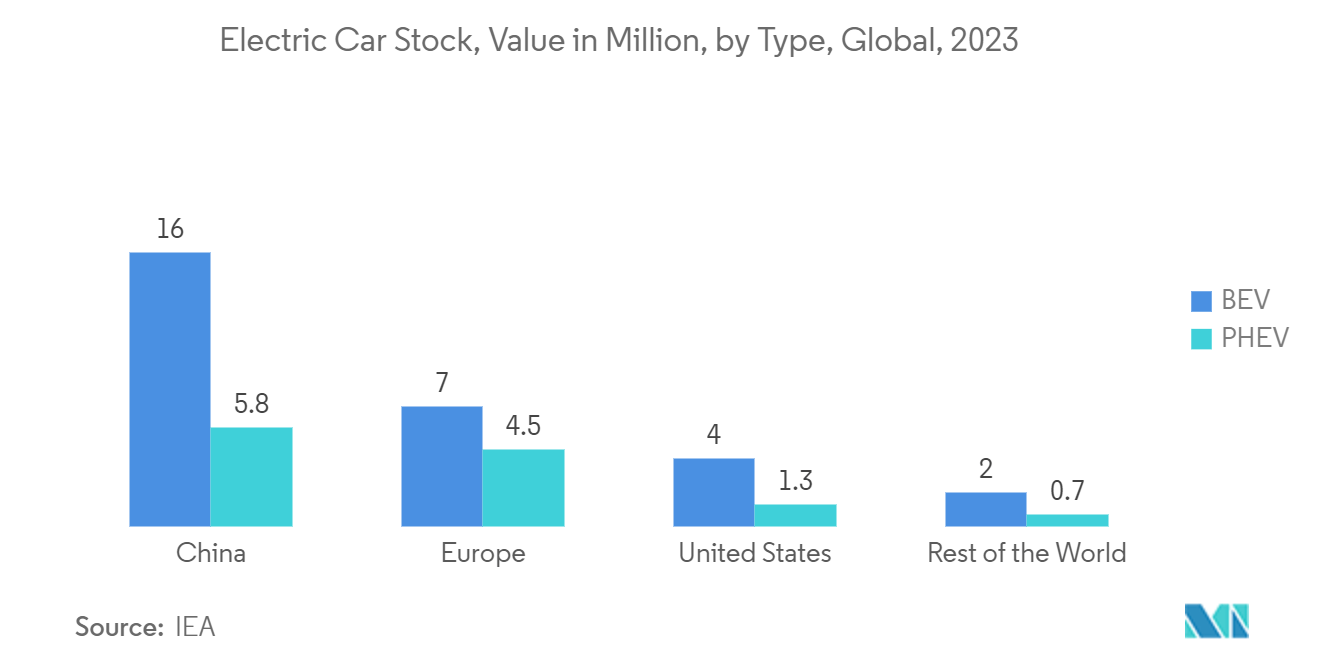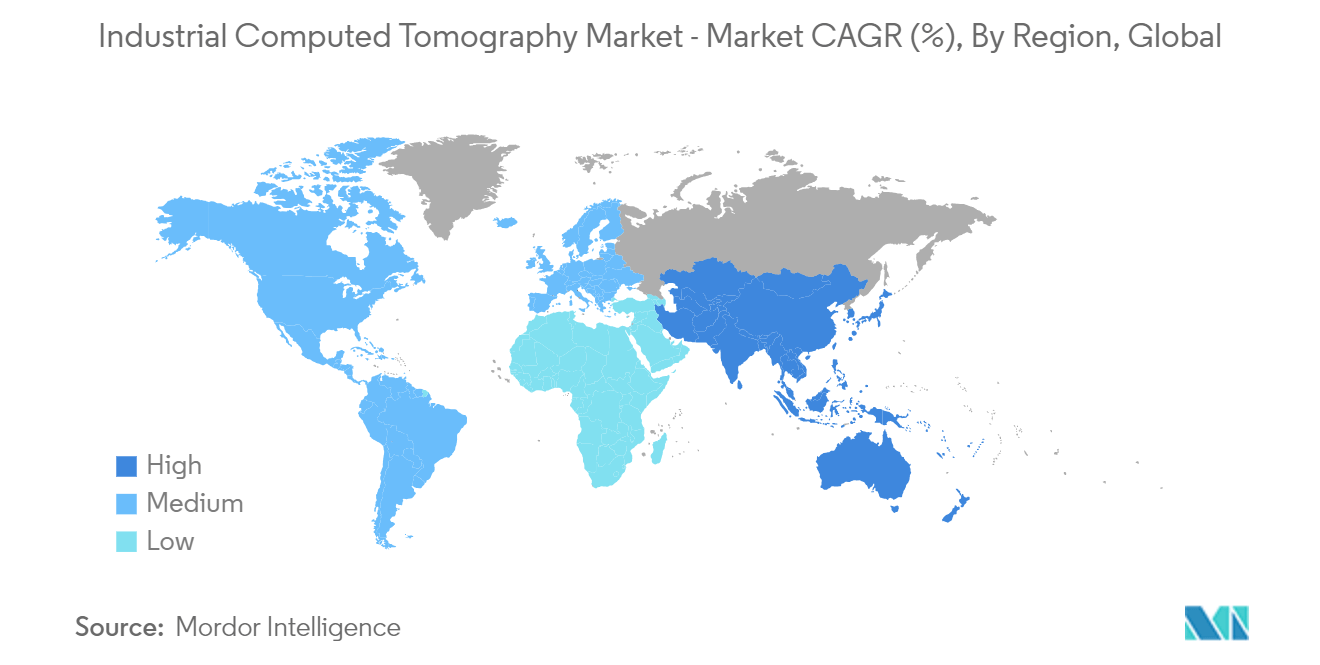Market Trends of Industrial Computed Tomography Industry
Automotive Industry to be the Largest End User
- Industrial CT systems are extensively used for quality assurance in automotive manufacturing. They provide detailed 3D images of components, allowing manufacturers to detect internal defects such as cracks, voids, and inclusions that may not be visible through traditional inspection methods. This capability is crucial for ensuring the reliability and safety of automotive parts.
- CT in the automotive industry is also used for applications, including inspecting castings used in engines and gearbox casings. Internal structures may be measured, and defects, including fractures, porosities, and inclusions, may be identified. Very large CT systems based on X-ray imaging solutions are able to scan complete vehicles to identify assembly defects or reveal how internal structures have deformed after crash testing.
- The automotive industry often involves complex geometries and intricate designs, especially with the rise of electric vehicles and advanced materials. Industrial CT can inspect these complex components, including engine parts, transmission systems, and structural elements, ensuring they meet design specifications and performance standards.
- Automotive companies can optimize production workflows by integrating industrial CT into manufacturing. Real-time feedback from CT inspections enables immediate adjustments, reducing waste and improving overall efficiency. This leads to cost savings and faster production times.
- According to Volume Graphics, one of the Austrian automotive suppliers reduced costs by around 50% after introducing industrial computed tomography (CT) as a measurement tool. Measurements using conventional optical and tactile inspection methods took 450 man-hours for the initial acceptance alone and destroyed the part in the process. Industrial CT provides insight into virtually all features of the part without destroying it and at lower costs. With the help of CT data and the macro and batch functionality, the same process only took 100 man-hours with only 80 more man-hours needed for final acceptance.
- At present, the testing for EVs has expanded to encompass more than just homologation testing for the vehicles and their components. It now involves evaluating charging interfaces and the associated systems that enable communication between the cars, charging stations, and back-office systems.
- Based on the Global EV Outlook 2024 by IEA, electric car sales in the United States are forecasted to increase by 20% in 2024 compared to 2023, resulting in nearly half a million more sales than in 2023. Despite recent trends and the upcoming tightening of CO2 targets in 2025, the growth in electric car sales in Europe is anticipated to be the slowest among the three most significant markets. Sales are expected to reach approximately 3.5 million units in 2024, showing a modest growth of less than 10% from the previous year. These developments are expected to drive the growth of the industrial CT market throughout the forecast period.

Asia Pacific Expected to Witness Significant Growth
- The Asia-Pacific region is a dynamic hub for several key industries, including automotive, aerospace, electronics, and oil and gas. The automotive industry in the Asia-Pacific region has witnessed significant growth over the past few decades, driven by rising consumer demand, urbanization, and the expansion of the middle class. Countries like China, Japan, and South Korea are anticipated to lead automotive production and innovation. China is the largest automotive market in the world, surpassing the United States in vehicle sales.
- The APAC region is at the forefront of automotive technology, with manufacturers investing heavily in research and development (R&D) for electric and autonomous vehicles. Major players like Toyota Motor Corporation, Honda Motor Co. Ltd, and Hyundai Motor Company are leading the charge with innovative technologies to reduce emissions and improve vehicle efficiency.
- The industrial CT market is gaining traction in the region, driven by the rising production and sales of electric vehicles (EVs) and the government's strong push for EV sales. Due to the increasing automotive sales in China, the government is prompted to enforce stringent emissions regulations to prevent significant environmental repercussions. China has introduced the China VI-b emission standards for light-duty, diesel-fueled, and heavy-duty vehicles nationwide, starting from July 2023.
- Moreover, the Indian electric vehicle (EV) market is projected to achieve a value of USD 7.09 billion (INR 50,000 crore) by 2025. According to a report from the CEEW Centre for Energy Finance, the Indian EV market is expected to be valued at USD 206 billion by 2030, which will require a significant investment of USD 180 billion in vehicle manufacturing and charging infrastructure. Furthermore, according to the China Association of Automobile Manufacturers (CAAM), China's new energy vehicle sales amounted to 597,000 units, of which 559,000 were passenger electric vehicles and 38,000 were commercial electric vehicles. An increase in demand for EVs is anticipated to significantly aid the demand for the studied market.
- Several leading automotive players in the country are expanding their presence by introducing new models, further creating demand for the ultrasonic flow meters market. For instance, in April 2024, Hyundai Motor Group, the umbrella organization of Hyundai and Kia, announced that it intends to launch its inaugural electric vehicles produced in India in an effort to solidify its position in the growing electric vehicle sector, which Tata Motors Limited presently lead, by 2025. Furthermore, Kia is set to introduce its electric vehicle manufactured in India around the same period. The group's objective is to reveal a combined total of five electric models by 2030.
- Fueled by Japan's ambitious goals of achieving net-zero emissions by 2050 and a 46% reduction by 2030, electric vehicles (EVs) are becoming increasingly popular. The government has set specific targets to support this transition, aiming for EVs and plug-in hybrid electric vehicles (PHEVs) to make up 20-30% of passenger car sales by 2030, with fuel cell vehicles (FCVs) targeted at 3%. Thus, the growing automotive industry in the country is expected to propel the growth of the market.


